archeology
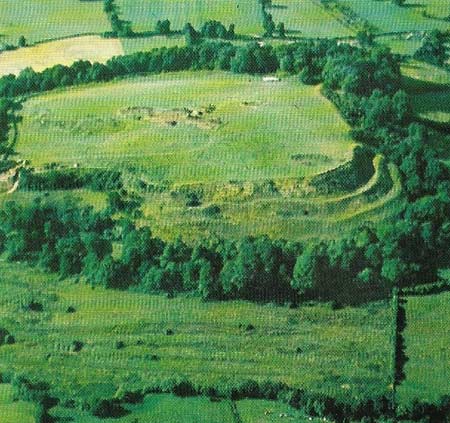
Figure 1. Cadbury Castle, Somerset, has been identified with Camelot, Arthur's court, since at least 1540. But in fact Camelot was simply the invention of 12th-century poets. Archaeological excavation, however, shows that Cadbury might instead have been the strong base or rallying point that Arthur needed to de-fend Britain against the Anglo-Saxons. The hillfort had been first built c. 500 BC, but was refortified with a stone and timber rampart and gates that can be dated to AD 460–540, the years in which Arthur flourished. The fort was strategically situated to resist any westward drive of the Anglo-Saxons from Wessex towards the Bristol Channel.
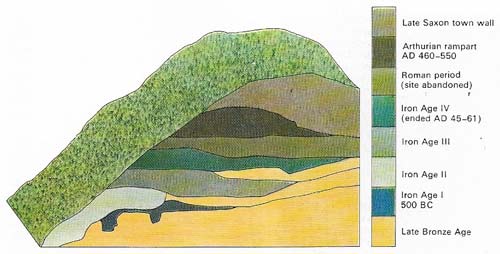
Figure 2. Stratification, the overlaying of earlier buildings by later ones, provides the basic clues by which archologists unravel the story of the past, particularly for a complex defensive system such as at Cadbury Camelot. Illustrated here is a schematic representation of the side of a trench excavated through the innermost of the four banks of the hillfort. At the base is the ground surface where the first Iron Age defense was built c. 500 BC. Below this was found pottery of the late Bronze Age, c. 1000 BC. The Iron Age Rampart I had a frame of wood that soon decayed, making it necessary to build Rampart II. This also collapsed and was followed by two other ramparts. The last, Rampart IV, was destroyed by the Romans in AD 45–61. After being abandoned for a long time, a new bank rampart was built. This was overlaid by a Late Saxon town wall about AD 1010, so it must be earlier than that, but later than the Iron Age. Contemporary pots suggest the date 460–550, the period of Arthur.
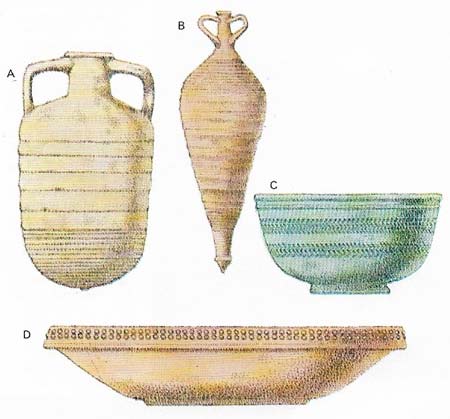
Figure 3. The study of pots is central to the archeologist's interpretation of the past. These reconstructed two-handled jars, (A, B) found at Cadbury, each about 50 centimeters (20 inches) tall, once contained Mediterranean wine for church services and princely feasts. The red dish (D) was also from the Mediterranean. Other pots have crosses inside the bowls and may have had a liturgical use. The gray bowl came from Bordeaux, perhaps with wine in wooden casks. Such pots found on sites in Britain reveal trade links and are important for dating, because in Greece similar pots can be dated by coins found with them, and these dates can then be transferred to the British sites.
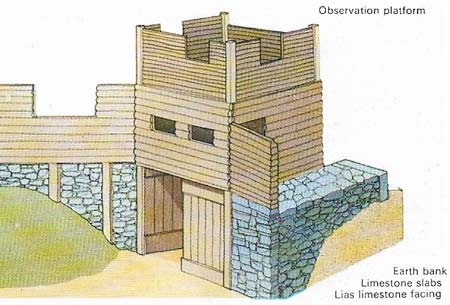
Figure 4. Reconstructions of the buildings can be attempted from the archeologist's study of the foundations, as in this gateway and rampart of the Arthurian period at Cadbury Castle. The remains consisted of the lower stones of the wall face; the pits in which the timber posts had stood; and dark stains in the ground where wood had rotted. If the tower has been correctly restored, its design may copy that of Roman military gate towers. But the rampart itself, with its use of timber and unmortared stone is very primitive it reveals the sharp decline of technology in the post-Roman centuries.
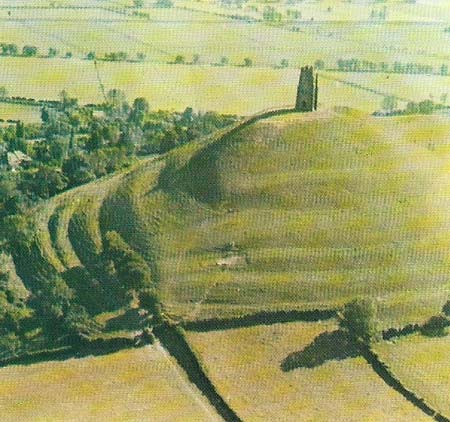
Figure 5. Glastonbury, Somerset, has many ancient legends. In 1191 monks at Glastonbury Abbey claimed to have found the tombs of Arthur and his wife Guenevere. All trace of these tombs subsequently disappeared. The claim attracted great interest at the time, when the legend of Arthur was beginning to spread beyond purely Welsh legend. Although it may have been made to attract visitors to the monastery to contribute to a building program, it is possible that the pair were indeed buried in the grounds of the Celtic monastery that originally occupied the site. Mediterranean wine jars of the 5th and 6th centuries have been found on Glastonbury Tor, (shown here), about 20 kilometers (12 miles) northwest of Cadbury.
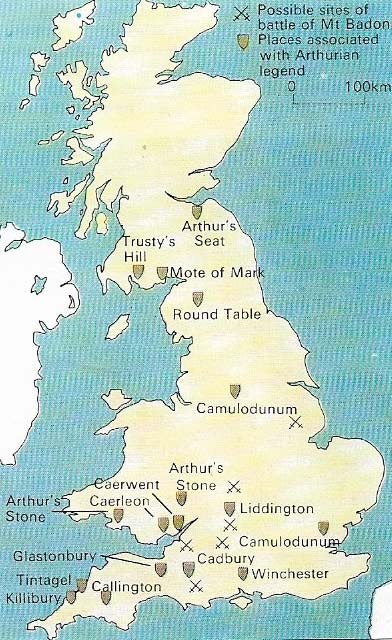
Figure 6. The Winchester Round Table can be shown, using historical tools, to have been made almost 1,000 years later than the period of the real King Arthur. History thus separates fact from fiction.
Archeology is the study of the past through identification and interpretation of the material remains of human cultures. A comparatively new science, involving many academic and scientific disciplines, including anthropology, history, paleography, and philology, it makes use of numerous scientific techniques. Its keystone is fieldwork.
Archeology was born in the early 18th century. There were some excavations of Roman and other sites, and the famous Rosetta Stone, which provided the key to Egyptian hieroglyphs, was discovered in 1799 and deciphered in 1818. In 1832 archeological time was classified into three divisions: Stone Age, Bronze Age, and Iron Age; though this system is now more commonly used for cultures of primitive man.
However, it was not until the 19th century that archeology graduated from its amateur status to become a more systematized science. Schliemann, Arthur Evans, Woolley, Carter, and others adopted an increasingly scientific approach in their researches.
Excavation is a painstaking procedure, as great care must be taken not to damage any object or fragment of an object, and each of the different levels of excavation must be carefully documented and photographed. The location of suitable sites for excavation is assisted by historical accounts, topographical surveys, and aerial photography.
Dating is accomplished in several ways. First, of course, is comparison of the relative depths of objects that are discovered. Analysis of the types of pollen in an object can provide an indication of its date. The most widespread dating technique is radiocarbon dating, incorporating the corrections formulated through discoveries in dendrochronology.
The work of the historian
The earliest historians relied largely on eyewitnesses, hearsay and word-of-mouth tradition. But England's first true historian, the Venerable Bede (673–735), also used written documents. Historians today extend their search even more widely. Government records for taxation and parish records tell about economic affairs. Art and poetry reveal cultural and spiritual life. Place-names show what diverse peoples have come to form a nation. Archeology exposes many aspects of both rural and urban life that are described in no documents. And for the long prehistoric era leading up to the invention of writing, archeology provides the only evidence.
Written records of King Arthur
The historian of early times often has to learn to use documents compiled long after the events they describe, or which copy, perhaps inaccurately, records that were contemporary. Or he may find legends and traditions wrapped round a kernel of fact, so that he has to peel off later fictions from a central truth.
A good example of the many tools used by historians to decipher fact from the most obscure evidence is the search for a historical basis of the semi-legendary King Arthur. In the period after the collapse of the Roman Empire in the 5th century AD, Anglo-Saxons from the far side of the North Sea and Scots from Ireland seized much of Britain from the native Britons and Picts, and in doing so created the basic racial mix of the British people. Our primary source for the recording of these events, the 6th-century British monk Gildas, describes a wholesale slaughter of the Britons by the pagan Saxons.
Gildas also records a great British victory over the invaders at Mount Badon (Figure 6), a battle that came to be associated with the name of Arthur. Most people think of Arthur as the idealized chivalrous king described by Thomas Malory in Le Morte d'Arthur (1470), or The Idylls of the King, by Alfred, Lord Tennyson (1809–1892), or in even later versions of these romantic tales. It is often assumed that such a figure must be mythical.
But by his study of the sources the historian can remove successive layers of romance to reach the historical truth. Arthur was first described as a great emperor in the 12th century in the History of the Kings of Britain by Geoffrey of Monmouth (c. 1100–1154). Three centuries earlier the British writer Nennius represented Arthur as the war-leader of the Britons against the Saxons. In his own day, records kept in a Welsh monastery refer to the victory of Badon, (now thought to have been fought c. 490), and to Arthur's death along with Mordred's at the battle of Camlann.
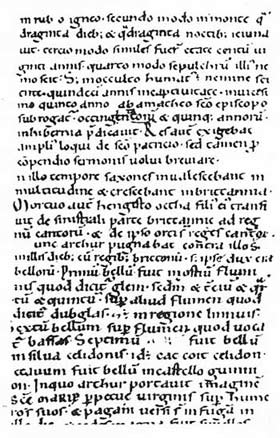 |
| Medieval manuscripts were handwritten, and errors or extraneous ideas might occur during later copying. This 9th-century account of the 12 battles that Arthur is said to have fought is by the Welsh monk Nennius, and is thought to have been a summary of an early Welsh poem of which no other record exists. None of the battle sites can be located with certainty, and the description of the battle at Mt Badon "in which 960 enemy fell in a single attack by Arthur" shows how the inflation of Arthur into a superhuman hero was underway by the time of Nennius. Arthur is called "leader of battles" for the British kings, a statement more likely to have been factual. |
This establishes Arthur as an historic personage – a great warrior, although not a king, who defended Britain against the Saxons. This is all the written documents can tell us. For further information we have to rely on the findings of the archaeologist.
The techniques of archeology
Archeology studies the physical remains of the past, and so gains insight into the material culture and living conditions of the characters of history. If documents prove that Arthur was a great war leader, then archaeology can show the kind of base that he may have fortified (Figures 1 and 4), and the weapons, jewelry and equipment that his followers used.
A wide armory of techniques is used to discover ancient sites, including walking the countryside, air-photography which gives a map-like view of sites (Figures 1 and 5), and geophysical prospecting to reveal ancient fireplaces, rubbish pits and other disturbances of the ground. Excavation is a precisely controlled process that seeks to recover the faintest traces of collapsed or decayed buildings (Figure 4).
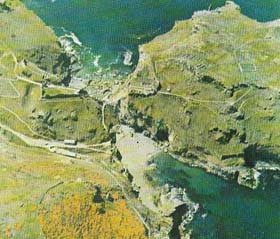 |
| Tintagel Castle, Cornwall, on a superbly defensible headland, was built in its present form in the 12th century. It has been linked with Arthurian legend since the work of Geoffrey of Monmouth, but probably was used in Arthur's day as a Celtic monastery. Mediterranean style pots of the period have been found there. |
For dating, the archaeologist traditionally relies on stratification (Figure 2), or layering, to reveal how later buildings lie on top of earlier ones; and typology (Figure 3) which compares developing types of the same class of object. The techniques of typology are familiar to anyone who can estimate the date and make of a car by its appearance.
Dating archeological finds
In historical periods, written references to sites, inscriptions, and dated coins, all help to establish chronology. Stratification and typology can only establish the relative age of sites and objects; not how old they are in absolute years. For this several scientific techniques have been developed. Some of these depend on radioactive decay, measuring the extent of the decay of the radioactive carbon present in all living things.
Another practice, that of tree-ring dating or dendrochronology, studies the annual growth rings of trees. The width of the rings varies from year to year in a distinctive rhythm. Counting back from the present, it is possible to match early phases of the rhythm on living trees with that on timber beams in ancient buildings. The tree-ring count may be extended backwards for thousands of years.
These techniques are most useful in prehistory, but they can also be applied to historic times. A clear example of this is the dating of the Winchester Round Table. Typological study of the carpentry suggests a date in the mid-14th century. Radiocarbon and tree-ring dates are consistent with this. Our historical knowledge of the growth of chivalrous ideals points to the same period. The table is part of the Arthurian legend; but it tells us nothing about the historic war leader of the Britons.
